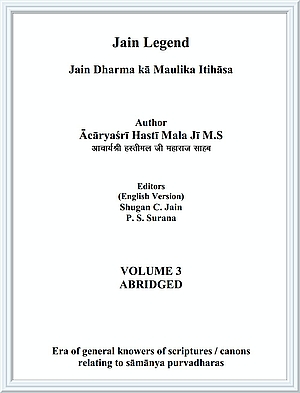| Name | 31st Śrī Vīra Sena | 32nd Śrī Vīra Jasa | 33rd Śrī Jaya Sena | 34th Śrī Hari Sena |
| Birth | V.N. 1040 | V.N. 1103 | V.N. 1100 | 1102 |
| Initiation | 1075 | 1118 | 1135 | 1140 |
| Ācārya position | 1116 | 1132 | 1149 | 1167 |
| Death | 1132 | 1149 | 1167 | 1237 |
| Householder | 35 years | 15 years | 35 years | 38 years |
| General monk | 41 years | 14 | 14 | 27 |
| Ācārya | 16 years | 17 | 18 | 30 |
| Lifespan | 92 | 46 | 67 | 95 |
31st epochal-ācārya Śrī Swāti
(Different from Hārila lineage Swāti)
| Birth | V.N.1089 |
| Initiation | V.N.1107 |
| General monkhood | V.N.1107-1115 |
| Epochal-ācārya | V.N. 1115-1197 |
| Death | V.N.1197 |
| Life span | 110 years 2 months 2 days |
After the death of 30th epochal-ācārya Jina Bhadra Kṣamāśramaṇa in V.N. 1115, Ārya Swāti was anointed to the post of epochal-ācārya by the four fold congregation.
Ārya Swati served the Jain congregation for 82 years as its epochalācārya. In this context, information is available from a verse in 'Vicāra Śreṇi' as follows:
In V.N. 1150, Swāti was the first ācārya to start the tradition of observing fortnightly ritual confession on 14th day of the fortnight.
However 'Ratna Saṃcaya' holy text gives a slightly different version in this context, which is as follows.
After V.N.1200, Sāi (Swāti) started observance of ritual confession on 14th day of the fortnight instead of the full moon night.
Dhārapadra gaccha
During the time of 34th pontiff of Lord Mahāvīra's tradition Ācāryaśrī Hari ṣeṇa, the 5th gaṇa-ācārya Baṭeśwara of Hārila gaccha started a sub division of this gaccha and named it as Dhārapadra gaccha, also known as Baṭeśwara gaccha.
Solaṃkī Paramāra King Thirapāla in Vikram 101 established a new town by the name Tharāda. Tharāda or Dhārapadra gaccha was established in this town and hence this gaccha became popular as Dhārapadra gaccha.
The fourth ācārya of Hārila gaccha, Yakṣa Datta had six principal disciples namely Nāga, Vṛanda, Mammaḍa, Durga, Agni śarmā and Baṭeśwara. Ācārya Yakṣa Datta anointed his all above named scholar disciples as ācāryas. Baṭeśwara was the junior most of the above six disciples.
Ācārya Baṭeśwara's principal disciple was Tattvācārya and the next in command was Udyotana who composed a supreme religious text called 'Kuvalayamālā'. This text became very popular and hence was called as the jewel of Prakṛata literature.
Yakṣa Mahattara, an associate monk with Udyotana, of ācārya Baṭeśwara had a profound observer of penance called Kṛṣṇarṣi who later established Kṛṣṇarṣi gaccha. This is also considered as an offshoot of Hārila gaccha.
In V.N. 1227, another branch of Dhārapadra gaccha by the name Piṣpalaka gaccha also came into being.
Dhārapadra gaccha had many influential ācāryas. In the later part of Vikram 11th century, one monk Śānti anointed by Ācārya Vādi Vaitāla Viruda wrote a commentary on Utarādhyayanasūtra.
On Bhādrapada Śuklā 5th i.e. Wednesday of Vikram 915 under the influence of Swāti planet (nakṣatra), when King Bhoja grandson of the king of Gwalior was ruling in Nāgaura, Ācārya Jaya Siṃha (disciple of Kṛṣṇarṣi of Dhārpadra gaccha) composed 'Dharmopadeśa' of 98 verses and its commentary with 5778 verses.
 Acharya Hasti Mala
Acharya Hasti Mala
